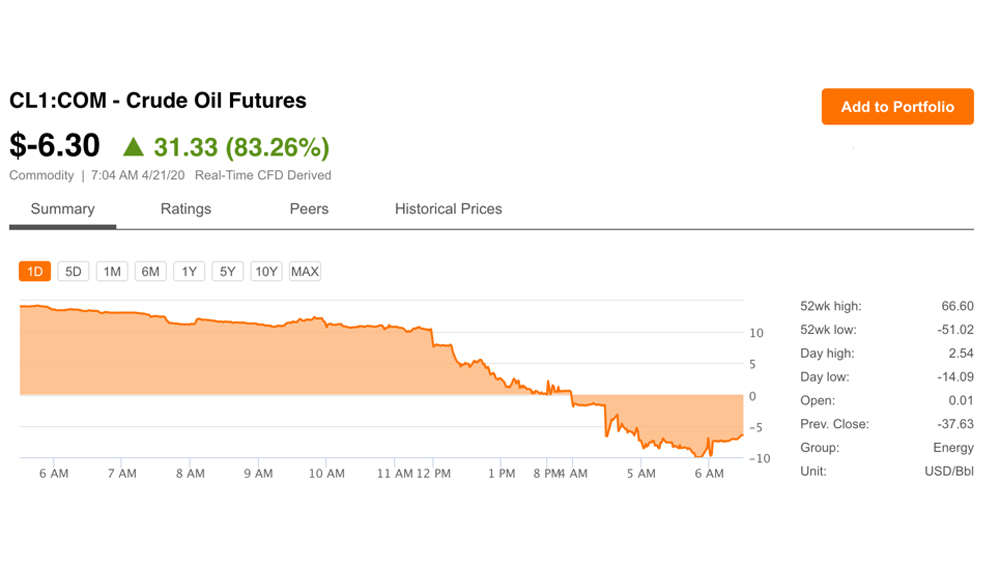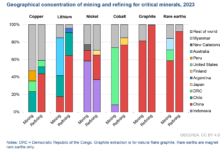Negative Oil Prices | “There Will Be Blood”
Our first thoughts after seeing the unfolding oil prices crisis was the title of the 2007 Hollywood movie: “There will be blood”. It is about the early years of the 20th century, when Daniel Plainview, an oil prospector, entangles himself in a story of family, religion, hatred, oil and madness, focusing on the ruthless nature of the early days of the oil business. Apparently, the real-life business was, is and will remain ruthless for the foreseeable future, and sometimes the global players bring the game past the thresholds of ‘sanity’.
It was not a surprise that oil demand would lower due to the shutdown of many sectors of the global economy; but this is not the whole story and the absurd started manifesting really recently. Demand for oil has plummeted in these recent weeks while the coronavirus pandemic has been shutting down multiple pillars of the economy, eliminating much of the need for fuel to transfers good or transport people. Without a use for it, the world’s biggest players (producers) are running out of places to store all the oil that companies continued to pump out of the ground but consumers did not ask for. To be more specific, crude oil is only the raw material from which gasoline is made after being refined to diesel, jet fuel and other products. Apparently, it is very costly for big corporations, like ExxonMobil and Royal Dutch Shell, to refine oil and transport it to gas stations. It requires employment of thousands of people throughout the supply chain sequence. In addition, state imposed and local taxes account for up to 20% of what customers pay at the gas stations in the United States. Similar is the example of many other European and Asian states, where taxes can bring the final prices even higher.
What happened?
This meltdown has never happened before, even if we did have collapses in the past, and experts did not expect prices to stay negative for much. Demand for oil is will probably remain volatile for months because few experts believe the economy will quickly rebound to where it was before the pandemic. As global demand for crude oil has plummeted, the United States has seen its oil storage capacity go out of the window because airlines and other buyers aren’t using nearly as much crude as they were before the crisis. WTI oil is down more than 100% this year; Brent oil has fallen about 65%. With storage at capacity, those companies that could store oil aren’t buying it anymore as they do not use it and have no space to store it. As sellers rushed to dispose (or more accurately, throw away) the May contracts, futures prices nosedived and plunged below zero for the first time. Those prices, of negative USD 4.47 per barrel, practically meant that companies would have to pay a buyer to take oil off their hands and store it if they want to exit the market. Of course, not many cases like that happened, but there will definitely be some interesting (or comical) stories of people who ended up with the May contracts and the bag in their hands.
International oil hasn’t been impacted as bad as its American counterpart. The June contract for Brent crude, the primary benchmark for global prices, is down about 23% to USD 19.67 per barrel. The main reason for this difference between the two benchmarks can be traced back to storage capacity. More specifically, crude is priced in the middle of the North Sea, where tanker storage is ample and accessible, while WTI oil storage in the U.S. is limited as well as landlocked. As a result, Brent is more removed from the coronavirus demand shock while WTI prices are much more sensitive to that shock.
Ultimately, the market continues to be severely impacted and directly connected with the pandemic’s status. Billions are still under lockdown or living under some version of a restrictive regime. Analysts keep trying to forecast, with an increasing acceptance that the shock to demand will probably last much more than initially expected.
Recently, Halliburton also offered a grim outlook for the oil market. “We expect activity in North America land to sharply decline during the second quarter and remain depressed through year-end, impacting all basins,” Halliburton’s Chief Executive Officer Jeff Miller said in a statement. The oilfield services giant reported a net loss of USD 1 billion for Q1.
Those weird figures may not be quite as large in May and beyond, but there is little chance that global demand will recover back to the levels of the glorious past. Mark Lewis, global head of sustainability research at BNP Paribas Asset Management, argues in the FT that “we may have just witnessed the permanent peak in oil demand. Greater efficiency, more EVs and also permanent changes in behaviour stemming from the pandemic could add up to a peak in consumption.”
Is this the end?
There are of course some mitigating factors in this equation and the insane numbers. The prices for WTI reflect the contract for May, which expires soon. The collapse is a reflection of traders abandoning the May contract, and moving on to June. The thinly-traded May contract loses some relevance, and analysts say that the June contract – trading at USD 20 per barrel as of April 20 – now becomes the important number to watch. The result is really part of the insanity and indicative of the situation: no one wants physical delivery of WTI for May, and with storage options dwindling in some places, almost panicked traders liquidated their positions, selling contracts at insane discounts. With the contract expiring on April 21, nobody wanted to be left holding the bomb. Unable to actually accept physical delivery, traders ended up paying someone to take oil off of their hands; hence the interesting stories mentioned earlier.
Louise Dickson, Oil Market Analyst at Rystad Energy, said in a statement: “The intraday WTI destruction today is certainly epic in scale, which is largely a case of jitters ahead of the WTI May 2020 futures contract expiring tomorrow and storage fears finally materializing. But if you have been watching the physical spot prices in the North Sea, currently trading in the USD 15-18 range, this drop in WTI May 2020 futures isn’t as shocking.”
This cringe and bizarre situation could be forgotten as traders move on to the June WTI contract, which has been trading at USD 20 per barrel. But while June doesn’t appear quite as catastrophic, oil at USD 20 is not a price at which most oil companies, or countries, can survive for a very long period of time. Moreover, nothing indicates (apparently) that USD 20 would be the absolute bottom of this barrel.
Is OPEC on top of this? Maybe not
The dramatic evolution of the plunging oil prices did not just start with the COVID19 crisis; it has its roots to the very delicate ‘peace pacts’ and the balance among global ruthless players – hence: “there will be blood”. Even if OPEC did agree to immense and almost monumental production cuts, Russia was at a brink of oil war with the Saudis just before this started. Saudi Arabia and Russia were already being pushed, by the circumstances, to produce less because they themselves were running out of room to store it. That would presumably help sustain the prices but the deal was fragile and the smaller, hungry players even more ruthless and uncontrollable. The cuts alone would not be able to retain the wave that was coming but eventually the war on the supply side met the demand destruction at the same time and we just got ourselves the perfect storm.
Russia and Saudi Arabia depend heavily on their oil revenues to sustain themselves. Even if the Saudis rely heavily (up to 50% of their GDP) on oil production, Russia is following (40% of their GDP). Even if Russia has a more diversified economy it still needs a price of 60 dollars a barrel to balance its budget. Accordingly, Saudi Arabia needs an 80 dollars-per-barrel price to balance its budget, realize its plans to diversify its economy and sustain a heavily subsidized economy. A price war would work for no one, right? Maybe, in a saner world than the one we live in.
The International Energy Agency warned: “There is no feasible agreement that could cut supply by enough to offset such near-term demand losses”. The agency expects that the plunging prices and increasingly reduced storage capacity will force U.S. producers to reduce production. By the end of the year, it expects output to be 2 million barrels per day lower than in December 2019. Their powerlessness in the face of the demand collapse was plainly visible in the latest capitulation. OPEC just seemed powerless to control this spiral.
Countries like Saudi Arabia, UAE and Kuwait depend on higher oil in order not just to budget themselves, but to survive. Smaller, and cheaper, players like Iraq, Iran and Venezuela face an actual existential threat oil prices remain at current levels. In Africa, the pandemic stopped the Nigeria growth story cold. For the United States and Canada, the spiral may have unforeseen consequences. Things are already getting out of hand whether president Trump wants to admit it or not.
“A return to sustainable prices will require a recovery of the global economy as well as disciplined production by OPEC and other major producers,” said Michael Garvey, head of oil & gas investment banking at Adour Capital. “The longer prices remain at these extreme lows, the more capital-starved the operations become, reducing production capacity,” Garvey said. “We are at the beginning of what will be a challenging period for the industry.”
While China cancelled 10 shipments of crude oil from Saudi Arabia for April and May, other OPEC members like African and South American states, and Iraq as well as Russia, not in the oil-producing cartel, are facing additional cancellations. Analysts expect more measures to regulate the situation but no one can predict or reassure for their effectiveness.
How the pieces are set on the global oil chess game
Saudi Arabia’s story is one of oil. The industry accounts for 70% of export earnings and half of GDP. With approximately USD 500 billion in their sovereign wealth fund the Saudis have the means to wait for the storm to pass. Saudi Arabia expected a rebound to 40 dollars per barrel following the peace treaty with Russia regarding the production and prices. With oil at the current price, the kingdom planned to take a loss of 40 billion. Even before the Russia-Saudi price war, Aljazeera reported the government had asked for state agencies to reduce costs by at least a third. Most probably, the central government will put on hold many major programs too. This will in no way guarantee stability for the long run, as more than a million jobs are at stake and much of the population is supported in some way by the government-backed social programs, which will now be have to be funded by the savings.
According to the Acuity oil and gas research, the unemployment rates across the UAE, could rise due to COVID19, but as in the case of the Saudis their savings can provide a short-term solution.
Iraq is the second-biggest oil exporter in OPEC. The Iraqis have nearly one tenth of the country’s population employed in state owned agencies and the vast majority of the funding is coming from oil. Similar to Iran, the pandemic effectively closed the Iraqi private sector economy since March. Iraq apparently, devasted by the wars, does not have sovereign wealth funds like many of its middle eastern counterparts to use as a reserve. Iraq is facing a potentially existential threat while this situation develops.
The pandemic had deep impacts on the demand from Russia’s largest clients like China, the European Union and not only. The cuts were particularly painful as Russia depends on oil shipments for at least a third of their GDP. Current oil prices undermine Russian efforts to protect its economy, including the recent peace treaty with Saudi Arabia to cut crude production as well as a government’s stimulus package. The heavy dependence of the Russians on oil is evidently putting at risk over a million jobs.
While the Mexican government announced stronger and deeper austerity measures the president also vowed there would be no layoffs of government employees. This is hardly imaginable as Mexico was a distant player in the Russian-Saudi shakedown. It was only in March that the Mexican oil industry seemed to defy the Saudi-Russia price war with Petroleos Mexicanos staying on track to double drilling to 423 wells by 2020. This proved how uncontrollable the global situation is and how little it matters if the ‘big boys’ agree or not.
Back in Africa, prices put the brakes on continent’s fastest-growing economy. With oil making up roughly 9% of GDP, Nigeria has a break-even oil price of USD 57 according to independent analysis from the oil and gas research team at Acuity Knowledge Partners. Oil is more than essential for governmental funding and it represents up to 90% of total exports. The IMF expects Nigeria’s economy to shrink significantly due to the crisis with the country keeping in storage up to 50 million barrels of unsold crude oil by May. Unemployment will reportedly rise by approximately 25%, even if more than 20 million people were already unemployed. Additionally, even if the country has some small savings (reportedly up to 2 billion US dollars), it will not be enough as a retainer to the spiral foreseen.
Canada was heavily impacted by the oil war between Russia and Saudi Arabia, with COVID19 launching an additional attack. Either of these two factors could have disrupted Alberta’s oil production but was meant to face their combined strength. The collateral damage seems indeed catastrophic.
Conclusion
All in all, some very useful and not so jaw dropping conclusions can be drawn out of this situation. First of all, the oil business is at the very mercy of COVID19; the longer the pandemic lasts, the greater the damage oil producers will have to take. Prices, through regulation, will most probably go up in the near future but no one can tell how high; marginal producers and the small players on the chess board are going to be eliminated or contained so this will help the ‘big boys’ set the game straight again.
Another conclusion is that OPEC, as an organization, seems unable to handle critical situations such as this one. It looks more like a ‘nice to have’ agency but not the game changing organization that would control the crisis and mitigate the global risks.
Additionally, we just witnessed that the big players are not willing to step down in their price shakedowns and will not hesitate to go toe to toe even if that hurts themselves and the business in total. The smaller players are even more ruthless, as they smelled the blood in this case and moved in immediately to cover the demand with even lower prices, only to make the situation worst.
Finally, it starts to become evident that oil seems to be turning into a hard to handle resource. Not just for its technical requirements but also because the world is slowly detaching itself from it. We have written in the recent past that evolutionary forces might be slowly pushing oil out of the big picture; that seems to be in contrast with the immense cloud of interwoven global interests that are directly linked to the oil business.
It only makes (some) sense for these global oil players to protect their interests through any means available (regulation, lobbying etc.), maintaining a very delicate balance within the ecosystem. In this case, the balance has been distorted both due to mistakes of the players but also primarily due to COVID19 – a very strong and unforeseen factor. It is only natural that when this essential balance is lost, chaos will break loose and the gentlemen’s agreements will go out of the window; hence “there will be blood”.







